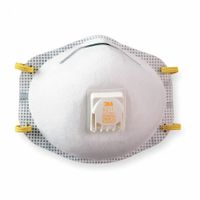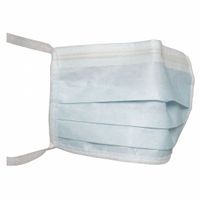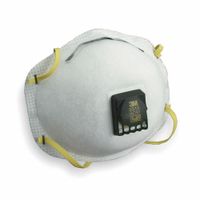Call +(254) 703 030 000 / 751 483 999 / 721 704 777
- Home
- Safety
- Respiratory Protection
- Disposable Respirators Masks
.....Read More
Frequently Asked Questions
What is the difference between N95 and KN95 masks?
N95 and KN95 masks are both designed to filter out at least 95% of airborne particles, but they differ in certification standards and design features.
N95 masks are certified by the National Institute for Occupational Safety and Health (NIOSH) in the United States. They are primarily used in healthcare settings and are designed to form a tight seal around the nose and mouth, ensuring minimal leakage. N95 masks must pass a rigorous testing process that includes evaluations of filtration efficiency, breathing resistance, and fit. They often feature headbands that provide a secure fit.
KN95 masks, on the other hand, are certified under China's standards, specifically GB2626-2019. While they also filter out 95% of particles, the testing and certification process differs slightly from that of NIOSH. KN95 masks typically have ear loops instead of headbands, which can affect the fit and seal. They are often used in non-medical settings and are more readily available for public use.
Both masks are effective in filtering out particles, but the fit and certification standards are the primary differences. N95 masks are generally preferred in healthcare environments due to their stringent testing and secure fit, while KN95 masks offer a more accessible option for general public use.
How long can you wear a disposable mask before it needs to be replaced?
A disposable mask should generally be replaced after a single use or when it becomes damp, soiled, or damaged. The effectiveness of a disposable mask diminishes once it is wet or contaminated, as moisture can reduce its filtration capability and make it less effective at blocking particles. Typically, a disposable mask can be worn for up to 4 to 8 hours, depending on the environment and level of exposure to contaminants. In high-risk areas or situations where the mask is exposed to a lot of particles, it may need to be replaced more frequently. Always follow the manufacturer's guidelines and local health recommendations for specific usage durations.
Are disposable masks effective against COVID-19?
Disposable masks, such as surgical masks, are effective in reducing the transmission of COVID-19. They act as a physical barrier to block respiratory droplets, which are the primary mode of transmission for the virus. When worn properly, these masks can significantly decrease the spread of droplets from the wearer to others, especially in situations where social distancing is challenging.
Surgical masks are designed to filter out large particles and droplets, and while they are not as effective as N95 respirators in filtering out smaller airborne particles, they still provide a substantial level of protection. The effectiveness of disposable masks depends on factors such as fit, proper usage, and the environment in which they are used. Masks should cover both the nose and mouth completely and fit snugly against the sides of the face without gaps.
Studies have shown that widespread mask usage in communities can lead to a reduction in COVID-19 cases. Masks are particularly effective when combined with other preventive measures, such as hand hygiene and physical distancing. They are most beneficial in indoor settings or crowded places where ventilation may be limited.
However, the effectiveness of disposable masks can be compromised if they become wet, soiled, or damaged. It is important to replace them regularly and dispose of them properly to maintain their protective benefits. While not a standalone solution, disposable masks are a crucial component of a comprehensive strategy to mitigate the spread of COVID-19, protecting both the wearer and those around them.
How do you properly dispose of a used mask?
To properly dispose of a used mask, follow these steps:
1. **Remove the Mask Safely**: Wash your hands with soap and water or use hand sanitizer before touching the mask. Remove the mask by handling the ear loops or ties, avoiding contact with the front of the mask.
2. **Inspect the Mask**: Check if the mask is damaged or heavily soiled. If it is, it should be disposed of immediately.
3. **Dispose of the Mask**: Place the used mask in a plastic bag or a lined trash bin. Ensure the bag is sealed or the bin is covered to prevent contamination.
4. **Do Not Reuse**: Single-use masks, such as surgical masks, should not be reused. Cloth masks can be washed and reused, but disposable masks should be discarded after one use.
5. **Wash Hands Again**: After disposing of the mask, wash your hands thoroughly with soap and water or use hand sanitizer to eliminate any germs you may have come into contact with.
6. **Environmental Considerations**: If possible, cut the ear loops before disposal to prevent wildlife from getting entangled. Be mindful of local guidelines for disposing of medical waste.
7. **Avoid Littering**: Never dispose of masks in public places or on the ground. This prevents environmental pollution and reduces the risk of spreading infections.
By following these steps, you ensure the safe and responsible disposal of used masks, protecting both public health and the environment.
Can disposable masks be reused after sterilization?
Disposable masks, such as surgical masks and N95 respirators, are designed for single use. However, in situations where supply is limited, certain sterilization methods can allow for their safe reuse. The effectiveness of these methods depends on the type of mask and the sterilization process used.
1. **Surgical Masks**: These masks are generally not recommended for reuse after sterilization due to their material composition, which can degrade and lose filtration efficiency. However, if necessary, methods like UV-C light and hydrogen peroxide vapor can be used, though they may not fully restore the mask's original protective capabilities.
2. **N95 Respirators**: These masks can be more effectively sterilized and reused. Methods such as vaporized hydrogen peroxide, UV-C light, and moist heat have been shown to maintain the mask's fit and filtration efficiency for a limited number of cycles. The CDC and NIOSH have provided guidelines on these methods, emphasizing that the mask should be inspected for damage and fit before reuse.
3. **Limitations and Considerations**: Each sterilization method has its limitations. For instance, UV-C light may not penetrate all mask layers evenly, and hydrogen peroxide vapor requires specialized equipment. Additionally, repeated sterilization can degrade mask materials, affecting fit and filtration. Masks should be discarded if they become soiled, damaged, or difficult to breathe through.
In summary, while disposable masks can be reused after sterilization in emergencies, it is crucial to follow specific guidelines and limitations to ensure safety and effectiveness. Regular inspection and adherence to recommended sterilization cycles are essential to maintain the protective qualities of the masks.
What is the NIOSH rating system for respirators?
The NIOSH rating system for respirators classifies particulate filtering facepiece respirators based on their resistance to oil and their filtration efficiency. The system is designed by the National Institute for Occupational Safety and Health (NIOSH) to ensure that respirators provide adequate protection against airborne particles.
The rating system uses a combination of letters and numbers:
1. **Resistance to Oil:**
- **N-Series (Not resistant to oil):** These respirators are suitable for environments free of oil aerosols. They are commonly used in settings where oil particles are not present.
- **R-Series (Resistant to oil):** These respirators can be used in environments with oil aerosols but are limited to a single shift or 8 hours of continuous or intermittent use.
- **P-Series (Oil-proof):** These respirators are suitable for environments with oil aerosols and can be used for longer periods, subject to the manufacturer's recommendations.
2. **Filtration Efficiency:**
- **95:** Filters at least 95% of airborne particles.
- **99:** Filters at least 99% of airborne particles.
- **100:** Filters at least 99.97% of airborne particles, similar to a HEPA filter.
Combining these, respirators are labeled as N95, N99, N100, R95, R99, R100, P95, P99, and P100. For example, an N95 respirator is not resistant to oil and filters 95% of airborne particles, while a P100 respirator is oil-proof and filters 99.97% of particles.
This rating system helps users select the appropriate respirator based on the specific environmental conditions and the level of protection required.
How do you ensure a proper fit for a disposable respirator?
To ensure a proper fit for a disposable respirator, follow these steps:
1. **Selection**: Choose the correct size and type of respirator for your face shape and the specific hazard.
2. **Inspection**: Check the respirator for any damage, such as tears or missing parts, before use.
3. **Positioning**: Place the respirator over your nose and mouth, ensuring the nosepiece is on top.
4. **Strap Placement**: Pull the top strap over your head and position it high on the back of your head. Pull the bottom strap over your head and position it around your neck, below your ears.
5. **Nosepiece Adjustment**: Use both hands to mold the nosepiece to the shape of your nose. Avoid pinching with one hand, as this can lead to an improper seal.
6. **Seal Check**: Perform a user seal check each time you wear the respirator. For a positive pressure check, exhale gently and feel for air leakage around the edges. For a negative pressure check, inhale sharply and ensure the respirator collapses slightly without air leaks.
7. **Fit Testing**: Undergo a fit test to confirm the respirator fits correctly. This should be done annually or whenever there is a change in facial structure or respirator model.
8. **Facial Hair**: Ensure no facial hair interferes with the seal of the respirator, as this can compromise its effectiveness.
9. **Comfort and Movement**: Ensure the respirator remains comfortable and secure during movement and talking.
10. **Reassessment**: Regularly reassess the fit, especially if the respirator shifts during use.
By following these steps, you can ensure a proper fit for a disposable respirator, maximizing its protective capabilities.



